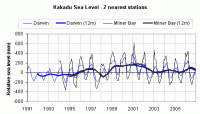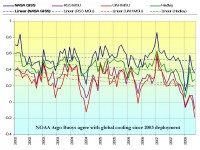Nov 03, 2008
Sea Level at Kakadu
By John McLean
Kakadu National Park is regarded as one of Australia’s iconic parks because of its flora, fauna, landforms and history. It is often claimed that this park is under threat from rising sea level so this discussion looks at what is known about sea level in the region. The park has about 100km of coastline fronting Van Diemen Gulf, which is basically a large bay with narrow entrances to the north (Dundas Strait) and the west (Clarence Strait). The East Alligator River and the South Alligator River, along with the smaller West Alligator River and Wildman River drain fresh water from the park into the Gulf.
It is claimed that the natural levees near the mouths of these rivers are as little as 20cm above water level and could easily be breached by rising sea level, which would cause salt water intrusion into fresh water systems.
What was found: Sea level at Darwin and Milner Bay has a regular cycle of higher sea in summer (Dec-Feb) and lower sea in winter (June-August).

See larger image here
For these two locations sea level varies synchronously and in accordance with the state of the ENSO system, rising as the SOI moves in a positive direction (i.e. towards La Nina) and falling as the SOI moves in a negative direction (towards El Nino). It therefore follows that sea level at previous times of strong La Nina conditions might have topped the natural levees of the freshwater rivers especially if the La Nina conditions existed across the summer period of high seas. These two conditions were met across 1975-6 with the month average SOI values of 19.5, 11.8 and 12.9 from December 1975 to February 1976, so the levees may have been breached on that occasion. In the archive of SOI values we find 13 other December-February periods of positive SOI values and similar breaches may have occurred at that time.
It is also noted that sea level at Darwin since 1998 is lower than the general relationship with the SOI suggests. (If the line for SOI is raised to match the line for sea level in the pre-1997 period then after 1997 the line for SOI will be above the line for sea level.) The reasons for this are not clear but it does suggest that sea level is rising less than might be expected. The 12-month running average of sea level at Darwin matches that at Milner Bay quite well so it seems unlikely that there was a sudden change in the height of the tidal guage.

See larger image here
Read full analysis here.
Nov 02, 2008
Anti-Energy Collaborative Effort in Colorado
Paul Chesser, Climate Strategies Watch
Over at my Web site I’ve posted a long, blow-by-blow account of how Colorado Gov. Bill Ritter and his administration repeatedly enlisted the William and Flora Hewlett Foundation to pay for his global warming alarmist agenda (a “new energy economy") and for his efforts to keep the federal Bureau of Land Management from leasing for oil and gas exploration on the Roan Plateau. It’s sometimes a dry recitation but there are a ton of documents linked that I obtained from the governor’s office and from CDNR.
The quick-’n-dirty summary: Almost immediately after he took office Ritter had a “Climate Action Plan” he wanted to pursue, which included two new positions in his administration: a cabinet-level climate policy adviser to create “a bold and visionary climate action policy,” and a liaison to the Public Utilities Commission to “develop a climate-wise utility policy.” He asked for, and got, two annual grants from Hewlett for $200,000 ($400,000 total) to fund the positions. Ritter worked through Hewlett’s environmental program director Hal Harvey—a far-left, Obama-supporting (and -contributing) environmental extremist who founded the Energy Foundation and is president of the crackpot enviro/population control-advocating New-Land Foundation—to pay for his climate people. I guess the state budget process would not come up with the money fast enough for Ritter.
Within a few months Ritter had another environmental cause to fight: obstructing and delaying the Bureau of Land Management from leasing the rights to oil and natural gas exploration on the rich Roan Plateau. It had been ten years already since BLM was given the mandate to lease the Naval Oil and Shale Reserves, and it was finally ready to start doing so after years of environmental study and review. But that still wasn’t long enough for Ritter, his eco-cronies, Reps. Mark Udall and John Salazar, and Sen. Ken Salazar (pictured). All got involved in trying to further delay BLM.

Part of the strategy was for Ritter’s administration to make the case for much slower “phased leasing”
of acreage on the Roan, as opposed to the BLM’s somewhat quicker but still limited and methodical approach. The governor’s Department of Natural Resources sought out (and found) a cheap economist who would be willing to put together a vague case that showed phased leasing was a better idea that would reap better revenues for the state. And can you guess who they asked to pay for said cheap economist? Yep—the Hewlett Foundation, with Hal Harvey more than happy to help out. In fact, Harvey wanted to help so much that he gave campaign contributions to both Salazars and Udall as well.
The congressmen worked at the federal level to implement Ritter’s phased leasing goals, with Sen. Salazar’s legal counsel begging for the suspect economic analysis to buttress his case. But the congressmen’s and Ritter’s efforts fell short of their goals, as BLM moved forward with the leasing, which netted nearly $114 million for both the federal and state governments—“the highest grossing onshore oil and natural gas lease sale in BLM history in the lower 48 states.”
Nevertheless, it’s a sorry tale of how environmental extremists will fight together to the death for measures that would cripple our access to our own sources of affordable energy.
Nov 01, 2008
“Global Warming” Has Stopped
Lord Christopher Monckton
In a blog post, Bill Chameides says “global warming” is still happening. It isn’t. As the global temperature graph below shows, all four of the world’s major global surface temperature datasets (NASA GISS; RSS; UAH; and Hadley/University of East Anglia) show a decline in temperatures that have now persisted for seven years.
‘Global warming’? What ‘global warming’? All four of the world’s major surface temperature datasets show seven years of global cooling. The straight lines are the regression lines showing the trend over past seven years. It is decisively downward. Chameides’ graph overleaf appears to have been tampered with to exclude the very rapid cooling that occurred between 2007 (the curve stops in January 2007, when a strong El Nino artificially but temporarily boosted temperatures) and 2008. The fall in temperatures between January 2007 and January 2008, carefully not shown on Chameides’ graph, was the greatest January-January fall since records began in 1880.

See larger image here
The UAH graph provides a complete answer to the Chameides’ attempt to suggest that skeptics” are confusing short-term and longer-term temperature changes. The year 2008 will turn out to have been no warmer than 1980 – 28 years ago. This is not a short-run change: the cooling trend set in as far back as late 2001, seven full years ago, and there has been no net warming since 1995 on any measure. Next, Chameides attempts to suggest that the recent cooling is caused by solar activity. He could well be right - however, if so, by the same token the warming that stopped in 1998 could also have been caused by solar activity - there was, after all, a solar Grand Maximum in the last 70 years of the 20th century, during which the sun was more active and for longer than at almost any previous similar period in the whole of the past 11,400 years.
Scafetta and West (2008) attribute more than two-thirds of the warming of the past 50 years to solar activity - the latest in a series of papers in all parts of the scientific literature that explicitly question the exaggerated estimates of climate sensitivity`perpetrated by the IPCC. Chameides’ final, desperate point is that the “green diamonds” he has so carefully selected from the 5-year running-mean graph that he has equally carefully blotted out show continuously-rising temperatures that overlay what he calls the short-term cooling.
Not so. As the first graph above shows, the linear regression not just for the past five years but for the past seven years shows a decisive and continuing cooling. Keenlyside et al. (2008) do not expect a new record year for global temperature to occur until at least 2015. If they are right, then the IPCC’s climate-sensitivity estimates must be - as Monckton (2008) finds them to be - prodigious exaggerations. False data will no longer convince any impartial mind to believe in the fantasy of anthropogenic “global warming”?

See larger image here
Oct 30, 2008
“Climate Smart” is Yesterday’s Vision
By Viv Forbes, Carbon Sense Coalition
Garbage out of Canberra:
Firstly, the Australian Treasury department has modeled the likely effect of the Emissions Trading Scheme on the Australian economy and assures us the costs will hardly be noticed. So we have IPCC General Circulation Models that have failed consistently to predict the world’s cooling temperature, and Federal Reserve Financial models that failed to predict the biggest financial collapse for 100 years, but we are asked to believe Australian Treasury Computer Models that say a massive new tax and dislocation of every important Australian industry will have no significant effect. And one of the adjustment factors used to achieve this Wong result for Minister Wong is the assumption that Australian industry will be able to buy foreign carbon credits much cheaper than they would be in Australia. So we pay big dollars to a Carbon Trader operating in Pakistan and Nigeria, he gets his mates to not cut down a forest they were planning to clear, and all is OK according to Minister Wong and her boffins with the computer.
Garbage out of London:
The irony - it snowed in London in October for the first time since, well opinions vary, some say 1934 some say 1922, but a long time anyway. The irony was not lost on those reporting the House of Commons debate on the global warming bill. Read the depressing saga and the result of the vote here.
And an Attempt to Clear some Garbage in Brisbane see this release:
“Climate Smart” is Yesterday’s Vision.
A statement by Viv Forbes, Chairman of the Carbon Sense Coalition. October 28, 2008
For Immediate Release.
The Carbon Sense Coalition today called on the Queensland Government to abandon their failed “Climate Smart” policy in favour of a new energy policy geared to the new realities of scientific re-assessment, economic austerity and international fragmentation. In a formal submission to the Queensland government, the Carbon Sense Coalition said that the tsunami of climate alarmism had reached its zenith.
As it recedes, a new climate of scientific scepticism and economic austerity will sweep green extremism from the political landscape. There will be no support for profligate spending on green baubles and beads, and no capacity for consumers or our basic industries to cope with the costs and dislocations of an Emissions Trading Scheme, especially as it becomes clear that nothing we can do will affect global temperatures.
The Queensland Government should forget party solidarity and instead stand up for the interests of the workers and consumers of tomorrows Queensland. These people want real industries producing useful goods and services and an end to “speculative waste” on feel-good causes like man-made global warming.
For more comment see: “Yesterday’s Vision” a submission covering all aspects of the Global Warming/Emissions Trading Debate.
Oct 30, 2008
Arctic Blast Brings London Earliest Snow in 70 Years. Cold and Snow in US Too!
By Mark Prigg, Science Correspondent
Londoners today woke up to the earliest snow cover for more than 70 years as a freezing blast of wind from the Arctic hit the capital. Some areas of north London saw two inches of snow fall in two hours when temperatures hit zero. Snow fell across much of the city from around 10pm, despite Met Office predictions that the city would escape the wintry showers that have swept across the north of England and Scotland leaving a thick covering.
In Brent, a heavy snow flurry caught residents by surprise as streets and cars were quickly covered in a white blanket. Graduate Charlotte Hussey, 21, said: “I was really excited and surprised, it was like Christmas had come early. I am going to go to the park today to build a snowman and go sledding.” Amid the snowfall, a man was taken to hospital after his car skidded off the M25 near Enfield. The Renault rolled over before landing in a ditch.
The cold snap with its widespread frost and crisp air is being caused by air from the Arctic replacing the normal south-westerly Atlantic breezes. “What we saw was the back edge of a weather system being blown down from the Arctic catching London,” said Byron Chalcraft, a Met Office forecaster. “The Arctic has been experiencing very cold temperatures this year, so it was an unusually cold front. Some unusual wind patterns meant it was blown over Britain very quickly, meaning the temperatures stayed very low. It is certainly very, very unusual to see snow in London this early,” said Mr Chalcraft. “The last time there was October snow [in the South-East] was in 1974, but the last time we actually had snow cover in October [in London], which we did late last night, was in 1934.” Read more here. See how this occurred on the same day the stubborn old fools in parliament passed the binding UK Climate Bill with 80% effect on emissions but zero effects on climate. See more on that ironic twist here.
It seems the louder the alarmists scream the colder the climate gets. If they keep it up, a new ice age is almost certain.
Here in the United States an arctic blast brought rare pre-Halloween heavy snows to parts of the east as far south as New Jersey and suburbs of Philadelphia. Up to 27” inches was reported in the Catskills. Here is a picture from Brunswick, New Jersey from a reader:

The snow extended down to North Carolina. See this video here.
The eastern cold reaches all the way down to southern Florida where Ft. Myers is expecting the coldest October temperatures in history (mid 40s). Read more here.
See the long list of record low temperatures set the last few days Oct_29_record_cold.pdf” title="here">here.
|








